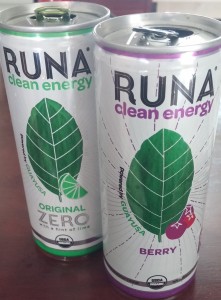When it comes to food, I’m not a fan of the term “clean energy”. I get
what this term is trying to convey, but as a food scientist, the term
makes me laugh inside. Same thing with the concept of a “zero-calorie
energy drink” (because a calorie is a measurement of energy). “Food
Science v Marketing” rant over, let me tell you about a new source of
“clean energy”.
The Energy Drink for the Month of February is Runa Clean Energy.
The Berry flavor is my favorite (shocker, if you’ve been following my other monthly picks).
I prefer not to drink my calories, but I much prefer the sweetness of
the Berry flavor than the zero-calorie version. I tried the “Original
Zero with a hint of lime” and, my word, it has an interesting flavor
profile. It starts with a carbonated zing akin to citric acid, then the
hint of lime shows up, followed by some earthly botanical notes that are
reminiscent of iced tea but slightly different, and not unpleasant. The
berry flavor is much more my style – short, sweet, and subtly strong.
5 Reasons to Recharge with Runa Clean Energy
keep reading -->
Food science in the news, Day-in-the-Life of a Food Scientist, caffeine safety, and the science behind energy drinks and other supplements. From the author of "ARE YOU A MONSTER OR A ROCK STAR: A Guide to Energy Drinks -- How They Work, Why They Work, How to Use Them Safely" -- note this blog has moved to GreenEyedGuide.com
Monday, February 23, 2015
Wednesday, February 11, 2015
Day in the Life of a Food Scientist Quality Professional – Risk Assessments
As I rounded the corner, I saw it overflowing. The Sample
Outbox on my desk was practically bursting with several Ziploc baggies of
different colored powder. My heart did a tiny leap of joy as I thought to
myself, Look at all these samples I need
to send to the lab!
In a previous post, I discussed how ingredient testing is a
large part of my job ["Raw Material Specialist (Extraordinaire)"]. I
also discussed how I consider samples that appear on my desk "presents",
because every new sample requires a preliminary Risk Assessment. But what is a
Risk Assessment, exactly, and why are they so fun?
Without realizing it, the average person does a risk
assessment almost every day.
At the grocery store: If I park in the back, I'm less likely to get a door ding by a self-absorbed teenager or a runaway grocery cart.
At work: If I don't erase this last sentence in my email, I could be in big trouble.
At home: If it was only on the ground for 5 seconds, it's still okay to eat.
For me, a Risk Assessment is an extensive background check
on a particular ingredient. The Risk Assessment considers the results of ingredient testing and a
literature search (among other factors).
Ingredient
testing is one way to make sure the ingredient is safe, but you have to know
what to test for.
 |
| You only get results for the tests you request, so better make sure you're looking for the right thing! |
You only get the results for the tests you request, so how
do you know what to ask for?
Sometimes the supplier will only test for Yeast and Mold and
Aerobic Plate Count (APC). APC is like a census – you may learn how many bugs you
have living there, but you can't tell how many of them are criminals. This is
why our standard ingredient testing regimen usually goes above and beyond the
tests an ingredient supplier will do on their own material. The literature
search also dictates what tests we request.
During my literature search, if I find any recalls for high
or unapproved pesticides, I need to make sure I request pesticide testing. If I
find reports of economically motivated adulteration (like putting vegetable oil
in something labeled 100% EVOO), I might test for identity or potential
adulterants.
Sometimes these searches turn up nothing significant…and
SOMETIMES, I hit the JACKPOT!
Sunday, February 1, 2015
Why Some Millennials Can't Cook -- Green-Eyed Insight
When you think back to the food you ate growing up, what comes to mind?
I have a theory on why certain Millennials are bad at cooking, but this is just a theory based on anecdotal evidence.
What are your thoughts on the matter?
For 2015, I am going to post one video per month. Please note I will NOT be using the same recording software I used to make this video, above, and I apologize for the quality.
---Green-Eyed Guide
I have a theory on why certain Millennials are bad at cooking, but this is just a theory based on anecdotal evidence.
What are your thoughts on the matter?
For 2015, I am going to post one video per month. Please note I will NOT be using the same recording software I used to make this video, above, and I apologize for the quality.
---Green-Eyed Guide
Subscribe to:
Posts (Atom)
